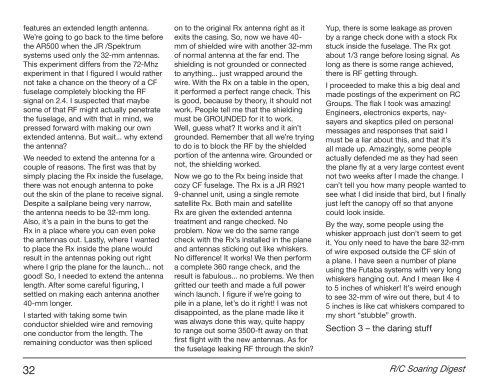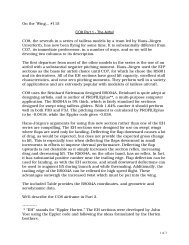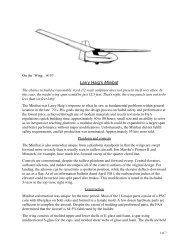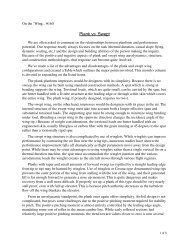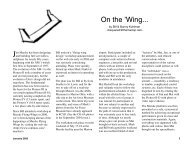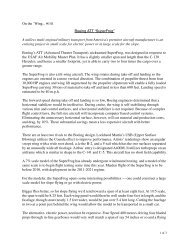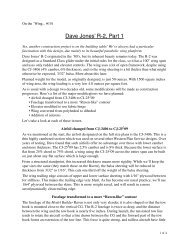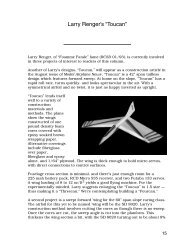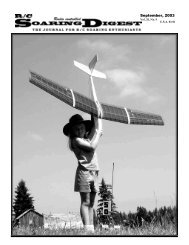Mar - Rcsoaring.com
Mar - Rcsoaring.com
Mar - Rcsoaring.com
Create successful ePaper yourself
Turn your PDF publications into a flip-book with our unique Google optimized e-Paper software.
features an extended length antenna.<br />
We’re going to go back to the time before<br />
the AR500 when the JR /Spektrum<br />
systems used only the 32-mm antennas.<br />
This experiment differs from the 72-Mhz<br />
experiment in that I figured I would rather<br />
not take a chance on the theory of a CF<br />
fuselage <strong>com</strong>pletely blocking the RF<br />
signal on 2.4. I suspected that maybe<br />
some of that RF might actually penetrate<br />
the fuselage, and with that in mind, we<br />
pressed forward with making our own<br />
extended antenna. But wait... why extend<br />
the antenna<br />
We needed to extend the antenna for a<br />
couple of reasons. The first was that by<br />
simply placing the Rx inside the fuselage,<br />
there was not enough antenna to poke<br />
out the skin of the plane to receive signal.<br />
Despite a sailplane being very narrow,<br />
the antenna needs to be 32-mm long.<br />
Also, it’s a pain in the buns to get the<br />
Rx in a place where you can even poke<br />
the antennas out. Lastly, where I wanted<br />
to place the Rx inside the plane would<br />
result in the antennas poking out right<br />
where I grip the plane for the launch... not<br />
good! So, I needed to extend the antenna<br />
length. After some careful figuring, I<br />
settled on making each antenna another<br />
40-mm longer.<br />
I started with taking some twin<br />
conductor shielded wire and removing<br />
one conductor from the length. The<br />
remaining conductor was then spliced<br />
on to the original Rx antenna right as it<br />
exits the casing. So, now we have 40-<br />
mm of shielded wire with another 32-mm<br />
of normal antenna at the far end. The<br />
shielding is not grounded or connected<br />
to anything... just wrapped around the<br />
wire. With the Rx on a table in the open,<br />
it performed a perfect range check. This<br />
is good, because by theory, it should not<br />
work. People tell me that the shielding<br />
must be GROUNDED for it to work.<br />
Well, guess what It works and it ain’t<br />
grounded. Remember that all we’re trying<br />
to do is to block the RF by the shielded<br />
portion of the antenna wire. Grounded or<br />
not, the shielding worked.<br />
Now we go to the Rx being inside that<br />
cozy CF fuselage. The Rx is a JR R921<br />
9-channel unit, using a single remote<br />
satellite Rx. Both main and satellite<br />
Rx are given the extended antenna<br />
treatment and range checked. No<br />
problem. Now we do the same range<br />
check with the Rx’s installed in the plane<br />
and antennas sticking out like whiskers.<br />
No difference! It works! We then perform<br />
a <strong>com</strong>plete 360 range check, and the<br />
result is fabulous... no problems. We then<br />
gritted our teeth and made a full power<br />
winch launch. I figure if we’re going to<br />
pile in a plane, let’s do it right! I was not<br />
disappointed, as the plane made like it<br />
was always done this way, quite happy<br />
to range out some 3500-ft away on that<br />
first flight with the new antennas. As for<br />
the fuselage leaking RF through the skin<br />
Yup, there is some leakage as proven<br />
by a range check done with a stock Rx<br />
stuck inside the fuselage. The Rx got<br />
about 1/3 range before losing signal. As<br />
long as there is some range achieved,<br />
there is RF getting through.<br />
I proceeded to make this a big deal and<br />
made postings of the experiment on RC<br />
Groups. The flak I took was amazing!<br />
Engineers, electronics experts, naysayers<br />
and skeptics piled on personal<br />
messages and responses that said I<br />
must be a liar about this, and that it’s<br />
all made up. Amazingly, some people<br />
actually defended me as they had seen<br />
the plane fly at a very large contest event<br />
not two weeks after I made the change. I<br />
can’t tell you how many people wanted to<br />
see what I did inside that bird, but I finally<br />
just left the canopy off so that anyone<br />
could look inside.<br />
By the way, some people using the<br />
whisker approach just don’t seem to get<br />
it. You only need to have the bare 32-mm<br />
of wire exposed outside the CF skin of<br />
a plane. I have seen a number of plane<br />
using the Futaba systems with very long<br />
whiskers hanging out. And I mean like 4<br />
to 5 inches of whisker! It’s weird enough<br />
to see 32-mm of wire out there, but 4 to<br />
5 inches is like cat whiskers <strong>com</strong>pared to<br />
my short “stubble” growth.<br />
Section 3 – the daring stuff<br />
32 R/C Soaring Digest


